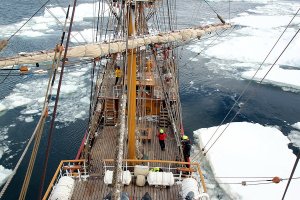Arto's Blog
| « The end of the Antarctic summer | An Argentinian village on the Antarctic Peninsula » |
Sunny whale watching on the Weddell Sea
Posted: 2015-07-27 23:51:00, Categories: Travel, Antarctica, Sailing, 597 words (permalink)Early Monday morning 9th of March we left Hope Bay, where we had
visited the Argentinian base Esperanza on the previous day, and
headed south to the Weddell Sea. The plan of the day was
exploration, trying to come as south as the ice conditions would
permit. We were partly following the route of the Nordenskjöld
expedition of the years 1901-1903, which reached the Snow Hill
Island about 60 miles south from Hope Bay.
There were many different types of ice floating around us, from
small pieces of sea ice to huge icebergs originating from glaciers
and ice shelves reaching from the continent to the sea. Our captain
Eric and the mate Elskarin, with the help of the crew members
sitting at a lookout point high up the mast, carefully navigated
through the icy waters, avoiding all big blocks but sometimes
pushing through some smaller pieces of ice.
Around midday we started seeing some patches of blue sky and in the
afternoon the sun came out. That moment everybody had been waiting
for and cheerful comments were heard all over the ship. The weather
had been good enough to go on land at every planned site but it had
always been cloudy since the middle of the Drake Passage where we
had our last sunny day.
Sunlight made the whole landscape around us look even more
spectacular, with icebergs shining in white and various shades of
light blue against the dark blue sea. Many put on harnesses and
climbed up in the masts to have a view from higher up. The wind was
just a gentle breeze, making it safe to climb and take photos from
the various lookout points the ship offered.
Occasionally we saw seals and penguins on top of the floating ice,
resting and enjoying the sun. Later in the afternoon, whales came to
greet the ship. A group of humpback whales blew fountains of air and
water drops high into the air and showed us their massive bodies and
white and yellow colored tails. Orcas were looking for seals to
catch and came several times to the surface between dives. Our guide
Jordi explained us how to distinguish between different species and
between male and female whales based on the form of their fins.
There were several sightings of whales during the afternoon and
evening, so we spent a lot of time outdoors wearing all our clothes
to cope with the below zero temperatures. At the end of the day,
after a zig-zag of searching and following ice free routes we
reached the southernmost point of our voyage, about 63 degrees 44
minutes south, next to the 11 mile long tabular iceberg called
B-15Y. It was actually a piece of B-15, the largest iceberg ever
recorded, a gigantic mass of ice which had broken off from the Ross
Ice Shelf on the other side of Antarctica 15 years earlier.
The sea was far too deep to anchor, so the captain let the ship
drift in the open water near the iceberg. While having dinner the
sunset shortly cast a red colour on a line of far away icebergs,
which marked the end of the marvellous day. During the night,
volunteers worked shifts on watching the radars in the wheelhouse
and the ice outside, to ensure that we wouldn't be hitting anything
large enough to damage the ship.
No feedback yet

Copyright Arto Teräs <ajt@iki.fi>, licensed under the Creative Commons Attribution-Share Alike 3.0 Unported License. (Unless otherwise mentioned in individual photos or other content.)






